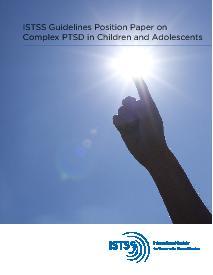ISTSS Guidelines Position Paper on Complex PTSD in Children and Adolescents
For the past two decades, there has been substantial debate about whether there are qualitatively different symptom profiles that can develop in children from different types of traumatic events and life circumstances. The term “complex trauma” is often used to describe both the presumed causes and the consequences of exposure to traumatic stressors when the child has experienced other significant adversities and is manifesting more severe clinical presentations.
The interest in an additional descriptive term or diagnosis has been fueled by trauma-focused treatment trials pointing to the fact that the experiences of many children involve more than the trauma and more than trauma-specific symptoms (e.g., children in foster care, residential treatment, juvenile justice). Efforts to classify these clinical presentations have included a proposed Developmental Trauma Disorder (Ford, et al, 2013).
The ICD-11 addresses the phenomenon through the adoption of a new diagnosis called Complex PTSD (CPTSD). The diagnosis of CPTSD requires the presence of a specific symptom profile and a traumatic experience but the type of traumatic event (e.g. complex trauma) is a risk factor rather than requirement for the disorder. CPTSD requires meeting the ICD-11 PTSD symptoms and three clusters that represent disturbances in self-organization (affect dysregulation, negative self-concept and disturbances in relationships).
The clusters comprise severe and pervasive problems in affect regulation; persistent beliefs about oneself as diminished, defeated or worthless, accompanied by deep and pervasive feelings of shame, guilt or failure related to the stressor; and persistent difficulties in sustaining relationships and in feeling close to others.
Geachte bezoeker,
De informatie die u nu opvraagt, kan door psychotraumanet niet aan u worden getoond. Dit kan verschillende redenen hebben,
waarvan (bescherming van het) auteursrecht de meeste voorkomende is. Wanneer het mogelijk is om u door te verwijzen naar de bron
van deze informatie, dan ziet u hier onder een link naar die plek.
Als er geen link staat, kunt u contact opnemen met de bibliotheek,
die u verder op weg kan helpen.
Met vriendelijke groet,
Het psychotraumanet-team.
8 pages | Oakbrook Terrace : The International Society for Traumatic Stress Studies (ISTSS)
http://www.istss.org/getattachment/Treating-Trauma/New-ISTSS-Prevention-and-Treatment-Guidelines/ISTSS_CPTSD-Position-Paper-(Child_Adol)_FNL.pdf.aspx


